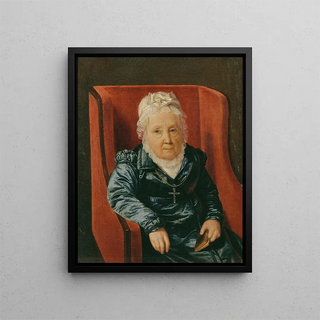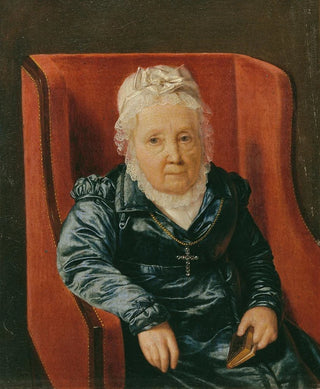Art print Rosina Wieser in an armchair - Ferdinand Georg Waldmüller | Art print


View from behind

Frame (optional)
In the fascinating world of 19th-century art, the art print "Rosina Wieser dans un fauteuil" by Ferdinand Georg Waldmüller stands out for its ability to capture not only the beauty of a frozen moment but also the very essence of its subject's personality. This painting, imbued with rare delicacy, transports the viewer into a world where intimacy and sophistication meet. Waldmüller, master of portraiture, manages to transcend simple representation to offer an immersive visual experience, where every detail tells a story. The art print of this iconic work allows appreciation of its depth while making it accessible to a broader audience eager to incorporate art into their daily lives.
Style and uniqueness of the work
Waldmüller's style is often characterized by meticulous realism, with particular attention to textures and human expressions. In "Rosina Wieser dans un fauteuil," he employs a palette of soft colors that evoke an atmosphere of serenity and comfort. Rosina's posture, delicately seated in her armchair, exudes natural elegance, while the play of light highlights the details of her dress and face. The artist excels at capturing nuances of emotion, allowing the viewer to feel an immediate connection with the subject. Each brushstroke seems charged with meaning, and the harmonious composition invites prolonged contemplation. Waldmüller thus succeeds in creating a work that, while rooted in its era, still resonates powerfully today.
The artist and his influence
Ferdinand Georg Waldmüller, born in 1793 in Vienna, is one of the major figures of the Austrian Romantic movement. His work is deeply marked by a desire to depict daily life and human emotions with rare authenticity. Waldmüller does not hesitate to diverge from academic conventions of his time, preferring to offer a more personal and intimate vision of his subjects. His influence extends beyond his era, inspiring many artists who, like him, seek to capture the truth of the human experience. By integrating elements of

Matte finish

View from behind

Frame (optional)
In the fascinating world of 19th-century art, the art print "Rosina Wieser dans un fauteuil" by Ferdinand Georg Waldmüller stands out for its ability to capture not only the beauty of a frozen moment but also the very essence of its subject's personality. This painting, imbued with rare delicacy, transports the viewer into a world where intimacy and sophistication meet. Waldmüller, master of portraiture, manages to transcend simple representation to offer an immersive visual experience, where every detail tells a story. The art print of this iconic work allows appreciation of its depth while making it accessible to a broader audience eager to incorporate art into their daily lives.
Style and uniqueness of the work
Waldmüller's style is often characterized by meticulous realism, with particular attention to textures and human expressions. In "Rosina Wieser dans un fauteuil," he employs a palette of soft colors that evoke an atmosphere of serenity and comfort. Rosina's posture, delicately seated in her armchair, exudes natural elegance, while the play of light highlights the details of her dress and face. The artist excels at capturing nuances of emotion, allowing the viewer to feel an immediate connection with the subject. Each brushstroke seems charged with meaning, and the harmonious composition invites prolonged contemplation. Waldmüller thus succeeds in creating a work that, while rooted in its era, still resonates powerfully today.
The artist and his influence
Ferdinand Georg Waldmüller, born in 1793 in Vienna, is one of the major figures of the Austrian Romantic movement. His work is deeply marked by a desire to depict daily life and human emotions with rare authenticity. Waldmüller does not hesitate to diverge from academic conventions of his time, preferring to offer a more personal and intimate vision of his subjects. His influence extends beyond his era, inspiring many artists who, like him, seek to capture the truth of the human experience. By integrating elements of
12,34 €






